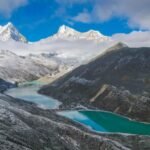FAQ: The Lakes of Tibet – An In-Depth Guide
Q: How many lakes are there in Tibet?
A: Tibet, a region known for its vast landscapes, is home to an impressive number of lakes. There are 612 lakes in Tibet that are larger than one square kilometer. Of these, 345 lakes span an area larger than five square kilometers. This count does not even include the lakes in other provinces of the Qinghai-Tibet Plateau.
Q: What makes the lakes in Tibet so notable?
A: When you open a map of Tibet on your smartphone, the most striking features are the numerous blue lakes scattered across its expansive territory. Contrary to the common perception of Tibet as a barren and arid plateau, it actually boasts the highest density and the widest distribution of lakes in all of China.
Q: Is Tibet mainly a dry and barren highland?
A: While the traditional image of Tibet is that of a desolate and dry plateau, in reality, it is a region with a rich array of lakes, contradicting its stereotypical image. The presence of these numerous lakes highlights the diverse and unique geographical nature of Tibet.
Q: How do these lake statistics compare with the rest of China?
A: The statistics of lakes in Tibet demonstrate the region’s significant contribution to China’s overall lake geography. With the largest density and distribution of lakes in China, Tibet stands out as a key area of interest for those studying Chinese lakes and natural landscapes.

Q: What is the total area covered by lakes in Tibet?
A: The lakes in Tibet cover a total area of 24,183 square kilometers, constituting about 30% of the total lake area in China. Remarkably, this area is nearly equivalent to the combined size of Beijing and Shanghai.
Q: Are most lakes in Tibet endorheic (closed basin) lakes?
A: Yes, 98% of Tibet’s lakes are endorheic, meaning they don’t drain into the sea or ocean. These lakes receive water from rivers and glaciers but only lose water through evaporation. Over time, this process increases the mineral content in the lakes, eventually turning many of them into saltwater lakes. Famous examples include Namtso, Siling Co, and Zhari Namco.
Q: How many of Tibet’s lakes are exorheic (draining)?
A: Only a few lakes in Tibet are exorheic, meaning they are connected to external water systems with continuous inflow and outflow, making them freshwater lakes. Examples include Basum Co, Mapam Yumco (Lake Manasarovar), and Ranwu Lake.
Q: Why is freshwater scarce in Tibet despite its many lakes?
A: Although Tibet is home to numerous lakes, the majority are not suitable for human use due to their high mineral or salt content. Consequently, Tibet faces relative water scarcity, emphasizing the importance of freshwater lakes.
Q: What environmental considerations should visitors to Tibet keep in mind?
A: Travelers to Tibet are urged to be environmentally conscious, particularly around rivers and lakes. It’s advised not to drive too close to lakes to avoid both vehicle damage and environmental degradation. Showing off luxury cars or driving skills is discouraged, and most importantly, littering in lakes must be avoided. Protecting this land is the responsibility of not just its residents but also every visitor.






